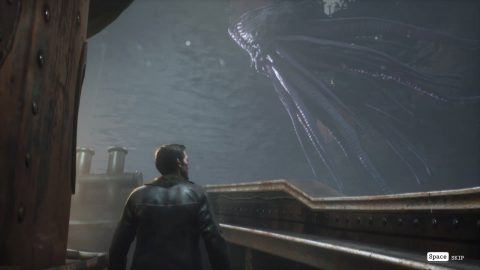So, if you play a lot of PC games and ever gotten an interest in playing The Sinking City, you may be extremely confused. This is understandable. The story goes that Frogwares, after leaving a deal with Focus Home Interactive to make a Call of Cthulhu game, decided to work on something original with the Lovecraft lore, and got a new distributor for the job. Bigben Interactive, now known as Nacon, helped with funding the game and distributing it, but had no control over the IP itself.
This is important because Nacon ended up being accused of breach of contract by Frogwares, due to a lack of payment and a supposed IP violation, bringing them to court and delisting various versions of the digital release. During this, Nacon just…put the game on Steam again. With a cracked copy, mind you, with stuff that their version of the game shouldn’t have, and with some assets changed to hide this. Nacon then made a counter argument that Frogwares was in the wrong and they had sole control of Steam distribution of the game, with Frogwares sending a DMCA takedown on that version, and trying to publish their own without mention of Nacon.
The version on Steam now appears to be entirely Nacon owned, or they may have come to an agreement, there’s been no word, but it kind of says a lot Frogwares hasn’t updated its own website listings since the mass delisting. They do seem to control the version on Origin, though, the last remaining place online where you can get a copy directly from the developer (via third party storefront). A lot…has happened.
The game itself is also really neat. The Sinking City is probably the best Lovecraft game ever developed, which is not a high bar, granted, but still quite the accomplishment. The key to this is that the game doesn’t feel like what you’d expect a Lovecraft game to feel like, even with all the expected pieces there (insanity system, sea horror, fish people, army vet getting wrapped up in a cosmic horror story, ect). The key to this is simple: The Sinking City doesn’t feel like it’s trying to scare you.
Let’s just be real for a moment and admit to ourselves that Lovecraft mythology hasn’t been scary in decades. Outside one odd good movie here or there, it’s mostly obsessed nerd stuff that has been explored and explained in exhaustive detail, with tons of expected tropes and story beats. The core ideas, like the horror of the depths of the sea or how we react with incalculably horrible truths, have become mundane in a world ravaged by climate change and where we regularly study deep sea creatures and how silly they look. It’s been a repeating series of the same stories over and over, with diminishing returns.
The ones that stick out are the ones that embrace how buck wild this stuff is. Weird mechanical diversions, bizarre tangents with other completely different eldrich creatures, and most importantly, a complete failure to horrify. Go back to Dark Corners of the Earth, it is nowhere near as horrifying as you may remember, especially when the guns come out. But you sure do remember that weird mess of a game, right? It was reverent to the source material, but also did whatever it felt like, resulting in a bizarre mess of ideas that are hard to forget.
The Sinking City is of this mold, with the added bonus of being a good game made by developers who had a better idea of what the game should be. You play as Charles Reed, a former navy man turned private eye in 1920s America who has gone down to Oakmont, Massachusetts. This town has been cut off from the world by a massive flood, which has caused eldrich shenanigans to run wild. Reed is here due to horrible dreams connected to the town somehow and you can guess the broad strokes already. To get the answers he seeks, Reed ends up doing PI work for the various factions in the town, including crime families and cults, and things unravel slowly from there.
It’s a similar structure to other open world games, with quest givers and the like, and the moral choice system and deduction board from Sherlock Holmes: Crimes & Punishments. Side cases remove the board (called a “mind palace” here) and stick to tests of your investigative skill, and also killing monsters. There’s a proper combat system here backed up with resources and crafting, thankfully pretty simple as to not overly complicate the flow of the game.
There are set areas of the town, thankfully marked by hobo signs (which also mark danger or useful loot containers), that have eldrich monsters present. They also tend to pop up during cases when you enter closed off areas. You can deal with them via guns, if you have the bullets, bombs, traps, and other such tools. You can even use bricks to draw enemy attention or, you know, hit them with a brick. The ideas work, and the use of resource scarcity never goes too far, as you can even get bonus chests when low on items and health as a last minute shot of turning things around.
The only major issue is general jank from Frogwares being new to gameplay like this. It’s pretty basic third person shooter stuff, complete with a more focused aiming stance and crotch walking for quiet approaches, but the animations and flow of enemies, Reed, and your weapons never really meshes right. The melee attack in particular has an odd range that’s hard to get used to. There’s also a lack of feedback when Reed is hit, though plenty when he takes psychic damage from looking at abominations too long. Doable, but since so much is in tight spaces, doesn’t always click as it should.
Due to that combat system, there is a proper experience system in play, Reed gaining experience from killing monsters and doing good investigation work. Every thousand nets a knowledge point, which can be used on perks like increased health or psyche (which lowers when encountering cosmic horrors), bonus experience, saving resources during crafting, better weapon use, and so on. This makes doing things always rewarding, even when stocked up on crafting material or bullets. It can also make bullets go further as you gain perks with firearms, increasing their effectiveness.
Oakmont also makes for a fun map itself, covered in barnacles, fish guts, and wear and tear from constant water fall and spread. Some streets around the town are also underwater, so you can cross them with scattered around motor boats, which can lead to areas off the beaten path for more secrets. It’s simple, with limited room for building climbing shenanigans, but it works well in a sort of dungeon crawler mindset. Each crevasse is most likely home to creepy crawlies, after all.
The place has mood. The sheer attention to detail on every area is impressive, even when clear copy and paste pops up for certain building layouts. The worn out walls, smashed up floors, and wilting posters make for a memorable spectacle alongside the varied weather and fantastic sound design. There are some stand out weird tracks, like one that seems to have some sort of warning sound weaved in and out. It makes the place feel truly oppressive, which is contrasted with well with the actual story and voice acting.
In true Frogwares fashion, there is a good mystery story here, having a lot of the expected Lovecraft beats, but dressing them in a way where it’s not clear how everything connects at first. The slow reveals of every faction and how they’re all in conflict brings in a crime war story in the middle of the evil octopus nonsense, making for a fun plot to uncover. There’s a lot of good payoffs, and the more obvious ones get obfuscated in clever ways. It genuinely keeps you on your toes, even if you know where the endgame is gonna be.
It’s also very goofy and pulpy. Reed makes for a great lead, a deadpan snarker mixed with an everyman, the exact right person to play off the normalized lunacy of Oakmont. Likable and relatable in his desires and reactions, but also able to make dark jokes at the wrong moments and put his foot in his mouth. It feels earned, with the colorful cast including a family of half-gorilla people, a librarian with a sown up mouth, and a fishman who carves toys for orphans when not helping to feed the needy that can also throw a harpoon so hard it clears a thick wall of wood. Every actor feels like they’re in on the cosmic joke of the game, creating an interesting feel for a cosmic horror story. The horrors are there, yeah…but you gotta put food on the table.
The cultural commentary does feel confused, though. Due to Oakmont being a flooded mess cut off from the world, racism is over somehow and now everyone hates fish people, who happen to be refugees. It never really lands, due partly to so many people being two faced, and also because most fish people you meet are apart of a cult trying to kill you or others. Could have used some more work, especially when the game has the KKK show up in a most random fashion. Very much a checking off the boxes for evil in Americana with a lack of thinking through.
There is something to be said for a lack of meat in the writing and cases. Unlike the later Sherlock Holmes: Chapter One, the mysteries here are often solved in a relatively straight line of leads, probably to better funnel you to combat encounters. There is great character work and a lot of surprises in the main plot, but those layers of intrigue aren’t as present or as well illustrated. This isn’t a bad thing, mind. The game messes with set pieces a lot more to make up for it, like having to dive to the depths and encounter sanity destroying creatures. It just depends on your tastes.
The Sinking City is a scrappy game that doesn’t have the budget for a content pile of larger open world games, but does knot how to use what it has well. It has an identity all its own, even among other Lovecraft inspired games, and really shows just how diverse Frogwares talents really are. Despite how hard it is to get a copy on PC actually under Frogwares control (who knows if the Origin version is even up wen this article goes out), it’s well worth it if you like off the cuff stuff that doesn’t get too experimental in play.
This is a real gem of creativity, something you couldn’t really see from any other team, even with the barnacles growing across its surface. It made Lovecraft feel fresh again with gameplay that was fun and consistent, even if being scary was not at all apart of that equation, and for that, it deserves props. If you want a more realized version of its investigation elements, including Reed’s crime scene recreations, check out Sherlock Holmes: Chapter One as well.


